Browning of boxwood: Is it boxwood blight?
While the browning and defoliation of boxwood is a key symptom of boxwood blight, there are a number of other look-alike plant problems.

Since boxwood blight has been found in Michigan for the first time in summer of 2018, growers, landscapers and consumers alike are concerned that their boxwoods could have boxwood blight. It is a legitimate concern because the disease has been found in Michigan and 27 other states. Boxwood blight (Calonectria pseudonaviculata) is a fungal pathogen of species in the plant family Buxaceae, which includes the popular boxwood, sweetbox and Pachysandra spp.
In boxwood, often the first symptom noticed is a large amount of rapid defoliation (leaf drop), which is indicative of a severe infection. Generally, part of the plant will become chlorotic or brown, and leaves will rapidly fall to the ground, leaving bare branches behind. Initial symptoms are generally first observed in late spring or early summer when close examination of boxwood leaves may reveal round, dark or light brown leaf spots with darker borders and potentially a yellow halo. These spots eventually grow larger and coalesce before turning brown or straw-like and dropping to the ground. Black, elongated, streaking lesions may also be visible on the stem. These can occur on the stem from the soil line to the shoot tips. If the weather is humid, the underside of the leaf will have a white, frosty appearance caused by the formation of upright bundles of fungal spores. For pictures of these symptoms, see “Preventing the spread of boxwood blight in landscapes.”
However, there are numerous reasons for defoliation and browning of boxwood plants. Here are seven common aliments of boxwood plants.
Winter injury
Winter injury is the most common problem that affects boxwood. It becomes apparent as the snow recedes and the uppermost or outermost leaves and stems on the boxwoods are brown. Buxus sempervirens is typically hardy down to USDA Zone 5. Plants are especially susceptible to winter damage in temperatures below -10 degrees Fahrenheit, especially in locations next to pavement or siding of the house with direct sunlight that warms the tissue up too quickly. Winter damage is especially distinctive in that the growth below the former snowline is still green. As long as the damage is not overly severe, growers can just prune out or prune off the damaged foliage.
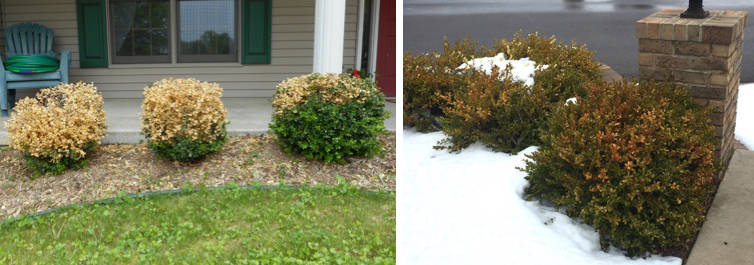
Salt damage
Salt used for sidewalks and roadways can cause damage to boxwoods. First, the spray of the salt water on the foliage can cause the plant to desiccate in those tissues, killing the leaves on one side of the plant. Excessive salt washed into the soil can also change the water uptake of the plant, causing salt damage. In these cases, it is most identifiable when there is a pattern where the boxwoods closest to walking surfaces show the worst damage. It is also noticed in spring.
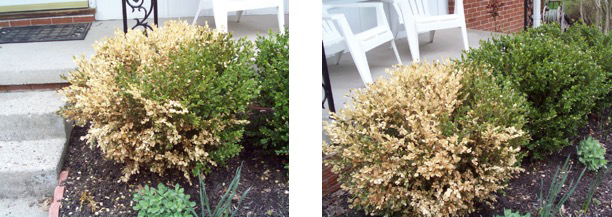
Drought stress
Boxwoods, like other plants, can show drought stress by the browning of foliage. Drought stress is the most severe in newly-planted landscapes where the plants are suffering from transplant shock, those without irrigation or rainfall for a long period of time, or those grown in very warm temperatures. The symptoms of drought stress are typically browning of the center of leaves and chlorotic foliage.
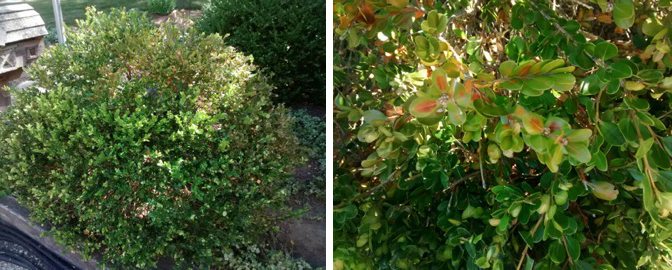
Boxwood leafminer
Boxwood leaves can turn brown from the boxwood leafminer. The adult leafminer (a mosquito-like fly) lays its eggs between the layers of the leaf and the developing larvae feeds on the tissue. The adults emerge from the leaves, leaving an emergence hole where they exited. The infested leaves will develop brown patches as the larvae grow and heavily infested leaves will defoliate in the late fall and early spring.
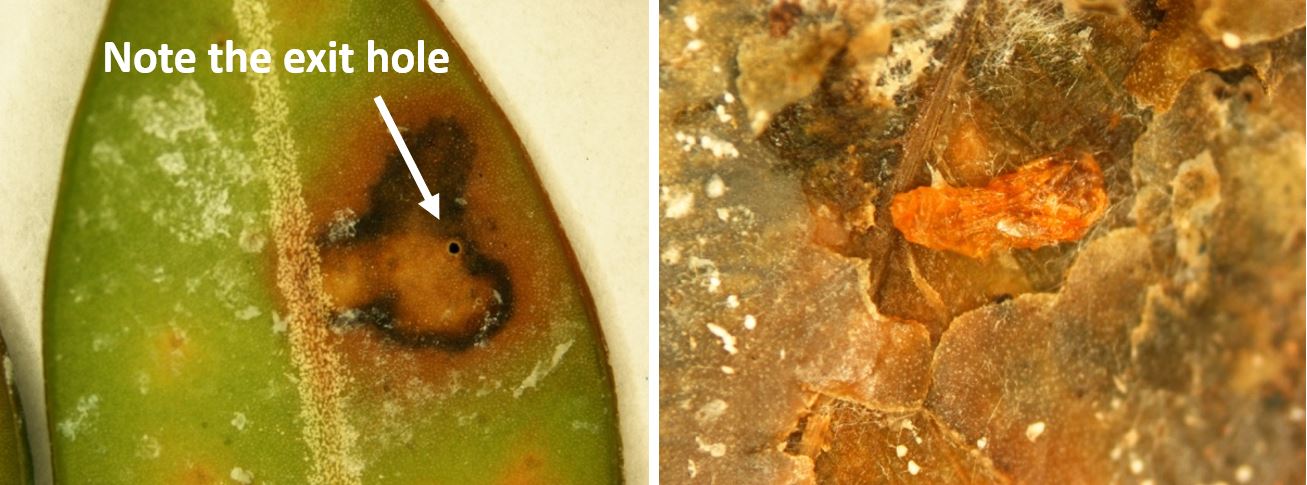
Volutella stem canker
In addition to abiotic problems and insect damage from boxwood leaf miner, boxwood is also susceptible to Volutella, a fungal pathogen caused by Pseudonectria buxi. Prior to the new growth in spring, the leaves will bronze and yellow. The fungus produces salmon/pink fruiting bodies when it is sporulating on the undersides of the leaves. On infected branches, the bark can become loose and they may dieback. It often causes the complete death of part of a plant.
Moist weather is conducive to the development of Volutella infection. One distinguishing difference between boxwood blight and Volutella is that the fruiting bodies or sporangia of boxwood blight are gray-white while they are pink-salmon for Volutella. In addition, the leaves do not fall off of plants with Volutella as they do with boxwood blight.
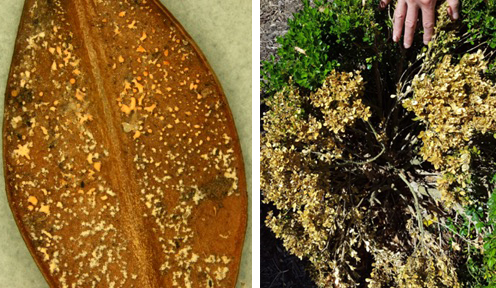
Macrophoma leaf spot
Boxwoods are also susceptible to Macrophoma leaf spot caused by the pathogen Macrophoma candollei. This parasitic fungal pathogen causes red-brown lesions on leaves and when sporulating has black fruiting bodies on the undersides of leaves.

Phytophthora root and crown rot
Phytophthora root and crown rot can also cause the wilting and browning of the foliage on boxwood plants. The fungi Phytophthora spp. can cause plant stunting, yellowing of leaves, upward turning of leaves, death of root tissues and discoloration on the stem of the plant near the soil line. Leaves of plants infested with Phytophthora root rot do not have any fruiting bodies.
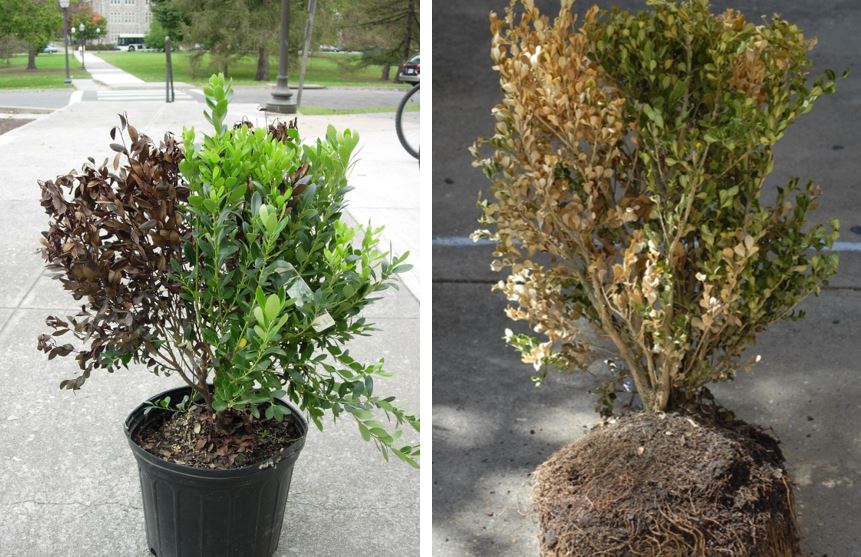
When looking at the boxwoods in your nursery or landscape, examine if there are any patterns to the damage and consider sending in a sample to get a confirmation by a diagnostic lab, such as Michigan State University Plant & Pest Diagnostics. These problems are often confused due to their similar symptomology. Diagnosticians will be able to help identify which of these common problems could be causing the plant damage.
For more information, check out “IPM Series: Boxwood” from University of Maryland Extension.
To learn more about preventing boxwood blight in commercial nurseries, check out “Preventing boxwood blight in nurseries” from MSU Extension, and for more information for landscapers and homeowners, check out “Preventing the spread of boxwood blight in landscapes.”



 Print
Print Email
Email

